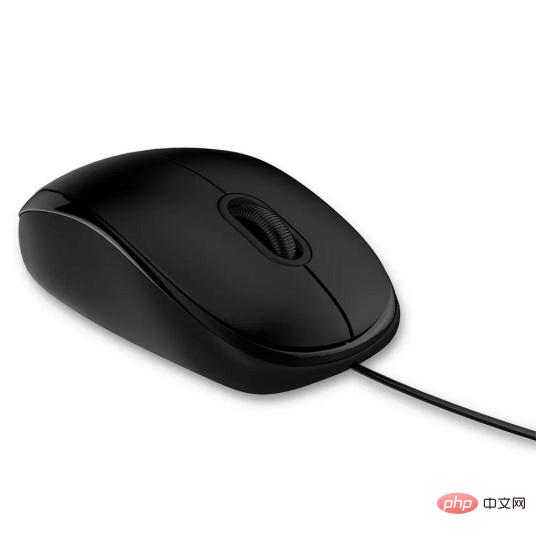Which interface on the host is the mouse plugged into?
The mouse is plugged into the host's serial port, PS/2 port or USB port. The serial interface is the oldest mouse interface. It is a 9-pin or 25-pin D-type interface. It can be used by connecting the mouse to the serial port of the computer host. The PS/2 interface is a mouse interface launched by IBM in 1987. It is a dedicated interface for mouse and keyboard. It is a 6-pin circular interface. The USB interface is a high-speed universal interface with a very high data transfer rate and supports hot plugging.

The operating environment of this tutorial: Windows 7 system, Dell G3 computer.
The mouse is an external input device for the computer and an indicator for positioning the vertical and horizontal coordinates of the computer display system. It is named after its mouse-like shape (called mouse in Hong Kong and Taiwan). Its standard name should be "mouse", and its English name is "Mouse". The use of the mouse is to make computer operation easier and faster, replacing the cumbersome instructions of the keyboard.

Common mouse interfaces include serial port, PS/2, and USB.
Serial port interface
The serial port is the serial interface, that is, the COM interface. This is the oldest mouse interface, a 9-pin or 25-pin D-type interface, which can be used by connecting the mouse to the serial port of the computer host. Its advantage is that it has the widest range of applications and models. It can be used from ancient computers without PS/2 interfaces and USB interfaces to the latest computers. Its disadvantage is that the data transmission rate of serial communication is too low, and mid-to-high-end mice cannot play their high role. Performance advantages, and does not support hot swapping.
PS/2 interface
The PS/2 interface is a mouse interface launched by IBM in 1987, commonly known as "small mouth". This is a dedicated interface for mouse and keyboard, a 6-pin circular interface. But the mouse only uses 4 pins to transmit data and power, and the remaining 2 pins are empty.
As shown in the two card slots, you can directly insert the keyboard or mouse into the purple or green card slot

Transmission rate of PS/2 interface It is slightly faster than the COM interface and is a standard interface for ATX motherboards. Although the PS/2 interface was once widely used, it does not support hot swapping and cannot allow high-end mice to fully exert their performance. Now it has been basically replaced by the USB interface. In the BTX motherboard specification, this is also an interface that will be eliminated soon.
It should be noted that when connecting a mouse with a PS/2 interface, you cannot plug the keyboard into the PS/2 interface by mistake (of course, you cannot plug a PS/2 keyboard into the mouse PS/2 interface). Generally, for a motherboard that complies with the PC99 specification, the mouse interface is green and the keyboard interface is purple. In addition, it can also be judged from the relative position of the PS/2 interface: the keyboard interface is close to the motherboard PCB, and the mouse interface is above it. interface.
USB interface
USB is the abbreviation of English Universal Serial Bus. The Chinese meaning is "Universal Serial Bus", which is a high-speed universal interface.

This is a new type of mouse interface. Before 2013, many new mouse products adopted USB interface. Compared with the first two interfaces, its advantages are very The high data transfer rate can fully meet the refresh rate and resolution requirements of various mice, enable various mid- to high-end mice to fully exert their performance, and support hot swapping.

USB devices mainly have the following advantages:
1. Can be hot-swapped. That is, when using an external device, the user does not need to turn off and on again, but can directly plug in the USB when the computer is working. [1]
2. Easy to carry. Most USB devices are known for being "small, light and thin", which is very convenient for users to carry large amounts of data with them. Of course, USB hard drive is the first choice. [1]
3. Unified standards. Common ones are hard drives with IDE interfaces, serial mouse and keyboards, and parallel port printers and scanners. But with USB, these application peripherals can all be connected to personal computers using the same standards. Then there are USB hard drives, USB Mouse, USB printer, etc. [1]
4. Can connect multiple devices. USB often has multiple interfaces on personal computers, which can connect several devices at the same time. If you connect a USB HUB with four ports, you can connect it again; four USB devices, and so on, you can connect as many times as you want. , connect all your home devices to a personal computer at the same time without any problems (note: can connect to up to 127 devices).
For more related knowledge, please visit the FAQ column!
The above is the detailed content of Which interface on the host is the mouse plugged into?. For more information, please follow other related articles on the PHP Chinese website!

Hot AI Tools

Undresser.AI Undress
AI-powered app for creating realistic nude photos

AI Clothes Remover
Online AI tool for removing clothes from photos.

Undress AI Tool
Undress images for free

Clothoff.io
AI clothes remover

AI Hentai Generator
Generate AI Hentai for free.

Hot Article

Hot Tools

Notepad++7.3.1
Easy-to-use and free code editor

SublimeText3 Chinese version
Chinese version, very easy to use

Zend Studio 13.0.1
Powerful PHP integrated development environment

Dreamweaver CS6
Visual web development tools

SublimeText3 Mac version
God-level code editing software (SublimeText3)

Hot Topics
 1386
1386
 52
52
 What are the internal interfaces of a computer motherboard? Recommended introduction to the internal interfaces of a computer motherboard
Mar 12, 2024 pm 04:34 PM
What are the internal interfaces of a computer motherboard? Recommended introduction to the internal interfaces of a computer motherboard
Mar 12, 2024 pm 04:34 PM
When we assemble the computer, although the installation process is simple, we often encounter problems in the wiring. Often, users mistakenly plug the power supply line of the CPU radiator into the SYS_FAN. Although the fan can rotate, it may not work when the computer is turned on. There will be an F1 error "CPUFanError", which also causes the CPU cooler to be unable to adjust the speed intelligently. Let's share the common knowledge about the CPU_FAN, SYS_FAN, CHA_FAN, and CPU_OPT interfaces on the computer motherboard. Popular science on the CPU_FAN, SYS_FAN, CHA_FAN, and CPU_OPT interfaces on the computer motherboard 1. CPU_FANCPU_FAN is a dedicated interface for the CPU radiator and works at 12V
 Common programming paradigms and design patterns in Go language
Mar 04, 2024 pm 06:06 PM
Common programming paradigms and design patterns in Go language
Mar 04, 2024 pm 06:06 PM
As a modern and efficient programming language, Go language has rich programming paradigms and design patterns that can help developers write high-quality, maintainable code. This article will introduce common programming paradigms and design patterns in the Go language and provide specific code examples. 1. Object-oriented programming In the Go language, you can use structures and methods to implement object-oriented programming. By defining a structure and binding methods to the structure, the object-oriented features of data encapsulation and behavior binding can be achieved. packagemaini
 Introduction to PHP interfaces and how to define them
Mar 23, 2024 am 09:00 AM
Introduction to PHP interfaces and how to define them
Mar 23, 2024 am 09:00 AM
Introduction to PHP interface and how it is defined. PHP is an open source scripting language widely used in Web development. It is flexible, simple, and powerful. In PHP, an interface is a tool that defines common methods between multiple classes, achieving polymorphism and making code more flexible and reusable. This article will introduce the concept of PHP interfaces and how to define them, and provide specific code examples to demonstrate their usage. 1. PHP interface concept Interface plays an important role in object-oriented programming, defining the class application
 Solution to NotImplementedError()
Mar 01, 2024 pm 03:10 PM
Solution to NotImplementedError()
Mar 01, 2024 pm 03:10 PM
The reason for the error is in python. The reason why NotImplementedError() is thrown in Tornado may be because an abstract method or interface is not implemented. These methods or interfaces are declared in the parent class but not implemented in the child class. Subclasses need to implement these methods or interfaces to work properly. How to solve this problem is to implement the abstract method or interface declared by the parent class in the child class. If you are using a class to inherit from another class and you see this error, you should implement all the abstract methods declared in the parent class in the child class. If you are using an interface and you see this error, you should implement all methods declared in the interface in the class that implements the interface. If you are not sure which
 Application of interfaces and abstract classes in design patterns in Java
May 01, 2024 pm 06:33 PM
Application of interfaces and abstract classes in design patterns in Java
May 01, 2024 pm 06:33 PM
Interfaces and abstract classes are used in design patterns for decoupling and extensibility. Interfaces define method signatures, abstract classes provide partial implementation, and subclasses must implement unimplemented methods. In the strategy pattern, the interface is used to define the algorithm, and the abstract class or concrete class provides the implementation, allowing dynamic switching of algorithms. In the observer pattern, interfaces are used to define observer behavior, and abstract or concrete classes are used to subscribe and publish notifications. In the adapter pattern, interfaces are used to adapt existing classes. Abstract classes or concrete classes can implement compatible interfaces, allowing interaction with original code.
 Insight into Hongmeng system: actual function measurement and usage experience
Mar 23, 2024 am 10:45 AM
Insight into Hongmeng system: actual function measurement and usage experience
Mar 23, 2024 am 10:45 AM
As a new operating system launched by Huawei, Hongmeng system has caused quite a stir in the industry. As a new attempt by Huawei after the US ban, Hongmeng system has high hopes and expectations. Recently, I was fortunate enough to get a Huawei mobile phone equipped with Hongmeng system. After a period of use and actual testing, I will share some functional testing and usage experience of Hongmeng system. First, let’s take a look at the interface and functions of Hongmeng system. The Hongmeng system adopts Huawei's own design style as a whole, which is simple, clear and smooth in operation. On the desktop, various
 Inner class implementation of interfaces and abstract classes in Java
Apr 30, 2024 pm 02:03 PM
Inner class implementation of interfaces and abstract classes in Java
Apr 30, 2024 pm 02:03 PM
Java allows inner classes to be defined within interfaces and abstract classes, providing flexibility for code reuse and modularization. Inner classes in interfaces can implement specific functions, while inner classes in abstract classes can define general functions, and subclasses provide concrete implementations.
 Java interfaces and abstract classes: revealing the inner connection between them
Mar 04, 2024 am 09:34 AM
Java interfaces and abstract classes: revealing the inner connection between them
Mar 04, 2024 am 09:34 AM
Interface Interface defines abstract methods and constants in Java. The methods in the interface are not implemented, but are provided by the class that implements the interface. The interface defines a contract that requires the implementation class to provide specified method implementations. Declare the interface: publicinterfaceExampleInterface{voiddoSomething();intgetSomething();} Abstract class An abstract class is a class that cannot be instantiated. It contains a mixture of abstract and non-abstract methods. Similar to interfaces, abstract methods in abstract classes are implemented by subclasses. However, abstract classes can also contain concrete methods, which provide default implementations. Declare abstract class: publicabstractcl



